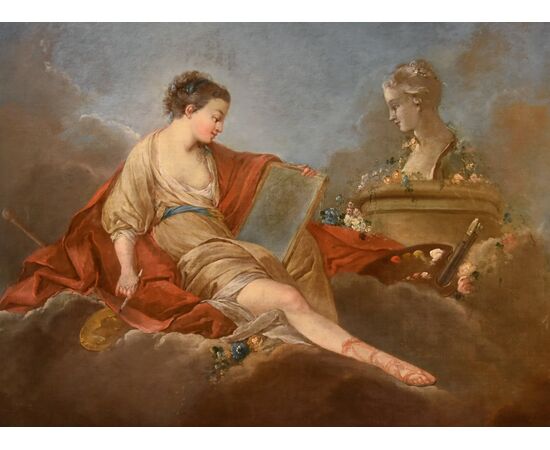Allegory of Painting, Pierre Charles Trémolières (Cholet, 1703 - Paris, 1739)
Pierre Charles Trémolières (Cholet, 1703 - Paris, 1739)
Allegory of Painting and Drawing
Oil on canvas (86 x 112 cm - In original lacquered frames 122 x 95 cm.)
Work accompanied by expertise from Prof. Emilio Negro
Complete details of the work (click HERE)
The painting is well-preserved and depicts a refined iconography inspired by learned classical literary models linked to the myth of Mount Parnassus, the Greek hill on which the Temple of Delphi stood and the waters of the famous Castalian Spring flowed, dedicated to Apollo and populated by the Muses, the source of inspiration and poetry.
On our canvas is depicted one of the legendary divinities inspiring creative fervor who, over the centuries, acquired a specific influence in the field of arts and knowledge: in this case, the Allegory of Drawing and Painting is portrayed, sitting on the clouds among flowers and painting tools (a hand rest, a palette, brushes), loosely dressed in silk while holding a drawing stick and a sheet on which she is drawing the sculpted bust of the young woman in front of her.
The learned subject illustrated and the peculiar dimensions of the painting suggest that it was originally an elegant "overdoor" intended to embellish the boiserie of the "studiolo" of an ancestral noble palace owned by a literate lover of music and the arts.
Regarding the stylistic characteristics of this Allegory, they highlight the work of a French school artist active in the 18th century, endowed with an elegantly casual creative vein and a happy predisposition for easel paintings on profane themes. The seductive depiction is in fact inspired by the best models of similar subjects produced between France and Italy in the mid-18th century: primarily the compositions of the French master Jean-Baptiste van Loo, from which our Allegory draws inspiration for the refined style imbued with a joyful theatricality.
Both the type of fluid painting with bright but nuanced colors, and the effective scenographic cut refer to the best French and Italian figurative culture of the Age of Enlightenment, and the comparison with the similar works of Pierre Charles Trémolières (Cholet, 1703-Paris, 1739) allows us to link our painting to the modus operandi of this interesting painter.
A talented scion of a noble family originating from the Loire region, Trémolières was invited to Paris by the Count of Caylus, his close relative, who managed to have him accepted into the prestigious Parisian workshop of Jean-Baptiste Van Loo, allowing him to win the second prize of the prestigious Grand Prix de Rome (1726) and subsequently admitted to the French Academy in the Urbe.
After a multi-year stay in the pontifical capital, now famous and established, he was recalled to his homeland where, at the height of his career, he was appointed head of the decorations of the Hôtel de Soubise, one of the most important Parisian residences (now the seat of the French National Archives), alongside other great painters such as François Boucher and Carle Van Loo.
In 1738 he previewed at the Paris Salon a beautiful painting 'Hercules and Hebe' destined to embellish the walls of the aforementioned important noble residence, which is still located in the prince's bedroom today.
Pierre-Charles Trémolières, Hercules and Hebe, Paris, Hôtel de Soubise (Prince's room) (fig.1)
These prestigious assignments, together with the pleasantness of his paintings, earned him a well-deserved fame that made him one of the most sought-after artists by Parisian nobles and wealthy bourgeois.
Therefore, in support of the proposal put forward, it will suffice to compare our beautiful Allegory, in addition to the work just mentioned, with others attributed to the French master, works in which the refined stylemes usually used by Pierre Charles Trémolières similarly stand out.
Among these, for example:
Pierre-Charles Trémolières, Venus and Cupid (Louvre, Paris) (fig.2)
https://collections.louvre.fr/en/ark:/53355/cl010054925
Pierre-Charles Trémolières, Allegory of Comedy (The Metropolitan Museum of Art, New York) (fig.3)
https://www.metmuseum.org/art/collection/search/437844
Pierre-Charles Trémolières, Venus holding a bow and quiver and Cupid holding an arrow
(Chritie’s 31.01.2023, Old Master Paintings and Sculpture Online, New York) (fig.4)
https://onlineonly.christies.com/s/old-master-paintings-sculpture-online/pierre-charles-tremolieres-...
Pierre-Charles Trémolières, Venus and Cupid (Artcurial, Paris France, November 08, 2011) (fig.5)
https://www.artcurial.com/ventes/1995/lots/31-a
Pierre-Charles Trémolières, The Triumph of Galatea (Tajan Auction Paris, 12 June 1995) (fig.6)
Pierre-Charles Trémolières, Flora and putto, private collection (fig.7)
ADDITIONAL INFORMATION:
The work is completed by a pleasant antique frame in turquoise lacquered wood and is sold with a certificate of authenticity and descriptive iconographic sheet.
We take care of and organize the transport of purchased works, both for Italy and abroad, through professional and insured carriers. If you wish to see this or other works in person, we will be happy to welcome you to our new gallery in Riva del Garda, in Viale Giuseppe Canella 18. We are waiting for you!
Contact us for any information, we will be happy to answer you.
Follow us also on:
https://www.instagram.com/galleriacastelbarco/?hl=it
https://www.facebook.com/galleriacastelbarco/

